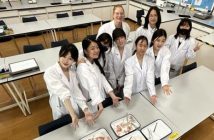
International Montessori School of Beijing (MSB) is a Kindergarten and Elementary school which has provided education in English and Chinese for Beijing’s international community for over 20 years. Caroline Chen, MSB’s founding principal, and a qualified qualified AMS Montessori teacher herself, answers our questions about the Montessori Method. Click here to read part two.
What is Montessori?
Montessori is named after Dr. Maria Montessori, an Italian educator of the early 20th century. She developed a teaching approach we now call the Montessori Method, which emphasizes a hands-on, individualized learning approach within a child-centered, mixed-age group classroom. Although best known as an educator, Dr. Montessori’s formal training was as a scientist and medical doctor and she was nominated for the Nobel Peace Prize three times.
Dr. Montessori developed her educational philosophy as a result of her scientific observations of the way children learn. She based her approach on the belief that children are individuals with their own strengths, needs, likes and learning styles. Her teaching strategies and her discoveries about the process of learning revolutionized the field of education and profoundly influenced children’s education all around the world. Today, Montessori schools most commonly encompass preschool and elementary grade levels. However the approach is also used extremely successfully in middle and high schools.
What are the core values of the Montessori educational approach?
Montessori education is based on the belief that children are individuals with their own strengths, needs, likes and learning styles. The teacher acts as a guide for each child through the learning process by using materials that fit their specific needs and pace.
A Montessori curriculum uses hands on, multi-sensory/multi-modality instruction. This means that concepts are not just taught by rote memorization or out of a textbook, but in a variety of ways using scientific designed materials that help the child to completely understand and also apply a lesson.
The learning in Montessori environment is activity based. The children are allowed to explore and learn through scientifically designed Montessori materials and in a prepared environment. The child is free to choose and work on the available material for as long as he/she wants, under the guidance from the teacher. The teacher in the Montessori classroom ensures that each child moves through the curriculum at an individualized pace, while making sure they meet national/international standards.
A Montessori education focuses not only on academic skills but also on essential life skills and character development. The Montessori social curriculum is incorporated into the academic curriculum at all levels and children learn how to behave in specific situations and acquire social skills for everyday living. The children develop a sense of personal dignity, an understanding of their culture, and an awareness and respect for people of all ages and traditions. Conflict resolution skills are taught and attention is given to making good choices. Having the appropriate social and language skills enables a child to engage positively in the classroom community and beyond.
What are the benefits of Montessori? What advantages does a Montessori school give children?
A Montessori based education is child-centered and is based on a child’s need, interest, learning style at that moment in their life. Instead of applying a “one approach fits all” style of learning to an entire classroom of children, the Montessori based approach takes into account that not all children learn the same way, have the same needs. Furthermore, it encompasses not only an academic curriculum, but also focuses on a child’s personal and social development. An important part of the Montessori education is in fact learning respect for one’s peers, learning grace, and courtesy. Montessori helps children to become self-motivated, self-disciplined, focused, and to retain the sense of curiosity that so many children lose along the way in traditional classrooms. Children are given the tools to be successful in their future life. They typically become life-long learners and problem solvers, they become innovators and good team players. They tend to act with care and respect toward their environment and each other. They are able to work at their own pace and ability.
From an early age exercises in grace and courtesy are presented daily and are a part of the curriculum. The children learn to behave in specific situations and acquire social skills for everyday living. The children develop a sense of personal dignity, an understanding of their culture, and an awareness and respect for people of all ages and traditions. Early conflict resolution skills are taught and attention is given to making good choices. This area of the curriculum also extends to the aspect of Citizenship. Students begin an empathy program, identifying feelings and studying virtues such as friendship, caring collaboration and more.

What is the difference between Montessori education and traditional education?
At every level in a Montessori program, the child actively participates in learning; the teacher’s role is to act as a guide. The child centered, individualized learning approach allows the child to choose his/her own work from interests and abilities, to formulate concepts from self-teaching materials, to set his/her own learning pace to internalize information. The classroom environment and mixed-age grouping encourages children to teach, collaborate and help each other and the individual and group instruction can adapt to each student’s learning style and level. Children are not required to sit and listen to a teacher talk to them as a group, but are engaged in individual or group activities of their own, with materials that have been introduced to them the teacher, who knows what each child is ready to do.
In the traditional educational model, there is an emphasis on learning by rote. The child is a passive participant in learning and teacher’s role is dominant and active. Most of the teaching is done by the teacher, and based on the adult’s teaching style. The child usually given specific time for work at an instruction pace set by group norm or teacher.
Dr. Montessori believed that teachers should focus on the child as a person, not on the daily lesson plan. Montessori teachers lead children to ask questions, think for themselves, explore, investigate, and discover. Their ultimate objective is to help their students to learn independently and retain the curiosity, creativity, and intelligence with which they were born. Montessori teachers don’t simply present lessons; they are facilitators, mentors, coaches, and guides.
There is great respect for the choices of the children in a Montessori classroom, but they easily keep up with or surpass what they would be doing in a more traditional setting. There is no wasted time and children enjoy their work and study. The children ask each other for lessons and much of the learning comes from sharing and inspiring each other instead of competing with each other.
Who accredits or oversees Montessori schools?
There are several Montessori organizations to which schools can belong. The two major ones operating in the United States are the Association Montessori Internationale (AMI, with a U.S. branch office called AMI-USA) and the American Montessori Society (AMS).
However there is no single organization which oversees all Montessori schools and accredits their programs. Thus the name “Montessori” can be used freely by schools whether they are offer true Montessori programs or not.

What is the main difference between a traditional classroom and a Montessori classroom?
A Montessori classroom does not look like a traditional classroom. A Montessori classroom is not filled solely with textbooks, writing paper and pencils. Rarely, if ever, will you find the whole class sitting with their books looking at the teacher showing them how to complete a task. Instead you will see children, some in groups, some by themselves, working on different concepts, and the teachers sitting with a small group of children, usually on the floor around a mat. Children typically work quietly and are focused on their work. There is a noticeable hum of productivity.
The classroom is filled with many materials that teach a wide range of levels and concepts. Shelves line the wall and are set up so that at a moment’s notice a teacher can reach for a material and teach a student or students the concept they need to know. The furniture is child sized so the students can easily access all the materials. Students can reach for the materials themselves and use them in the way that they were taught so that they can practice a concept that they are working on.
What materials are used in a Montessori classroom? What special training do Montessori teachers have and how are they different than traditional teachers?
Dr. Montessori believed that teachers should focus on the child as a person, not on the daily lesson plan. Montessori teachers are specially trained to lead the children to ask questions, think for themselves, explore, investigate, and discover. Their ultimate objective is to help their students to learn independently and retain the curiosity, creativity, and intelligence with which they were born. Montessori teachers don’t simply present lessons; they are facilitators, mentors, coaches, and guides.
Traditional teachers often say that they "teach students the basic facts and skills that they will need to succeed in the world." Studies show that in many traditional classrooms, a substantial portion of the day is spent on discipline and classroom management.
Normally, Montessori teachers will not spend much time teaching lessons to the whole class. Their primary role is to prepare and maintain the physical, intellectual, and social/emotional environment within which the children will work. A key aspect of this is the selection of intriguing and developmentally appropriate learning activities to meet the needs and interests of each child in the class.
Montessori teachers usually present lessons to small groups of children at one time and limit lessons to brief and very clear presentations. The goal is to give the children just enough to capture their attention and spark their interest, intriguing them enough that they will come back on their own to work with the learning materials. Great teachers help learners get to the point where their minds and hearts are open, leaving them ready to learn. In effective schools, students are not so much motivated by getting good grades as they are by a basic love of learning.
What is the benefit of a multi-age classroom?
One of the core principles of a Montessori based education is the belief that mixed age groups and flexible groupings allow the children to learn at the best rate.
A mixed-aged classroom offers an inherent motivator for children to constantly challenge themselves. The older children benefit tremendously from this environment as they become teachers and leaders, developing confidence and independence. They can reinforce their understanding of the material by teaching it to the younger students, while the younger ones have it taught to them in different ways. Sometimes another child can word a concept in a way that an adult can’t, facilitating better understanding for both children involved.
This process of sharing what they know reaffirms what they have already learned. Younger children usually want to do what the older children are doing and benefit from having role models in their classroom environment.
Multi-age classrooms also allow children to excel. Children can easily advance in the complexity of their work without waiting for the group as a whole. With higher-grade level materials easily accessible, and the possibility to teach children at different levels, students with a high aptitude in a subject matter can easily work above grade level. In other words, a well functioning multi-age classroom will be able to adapt to the needs of each child, promoting enrichment and support in the specific concepts that each child needs to work on.
Photos courtesy of International Montessori School of Beijing



